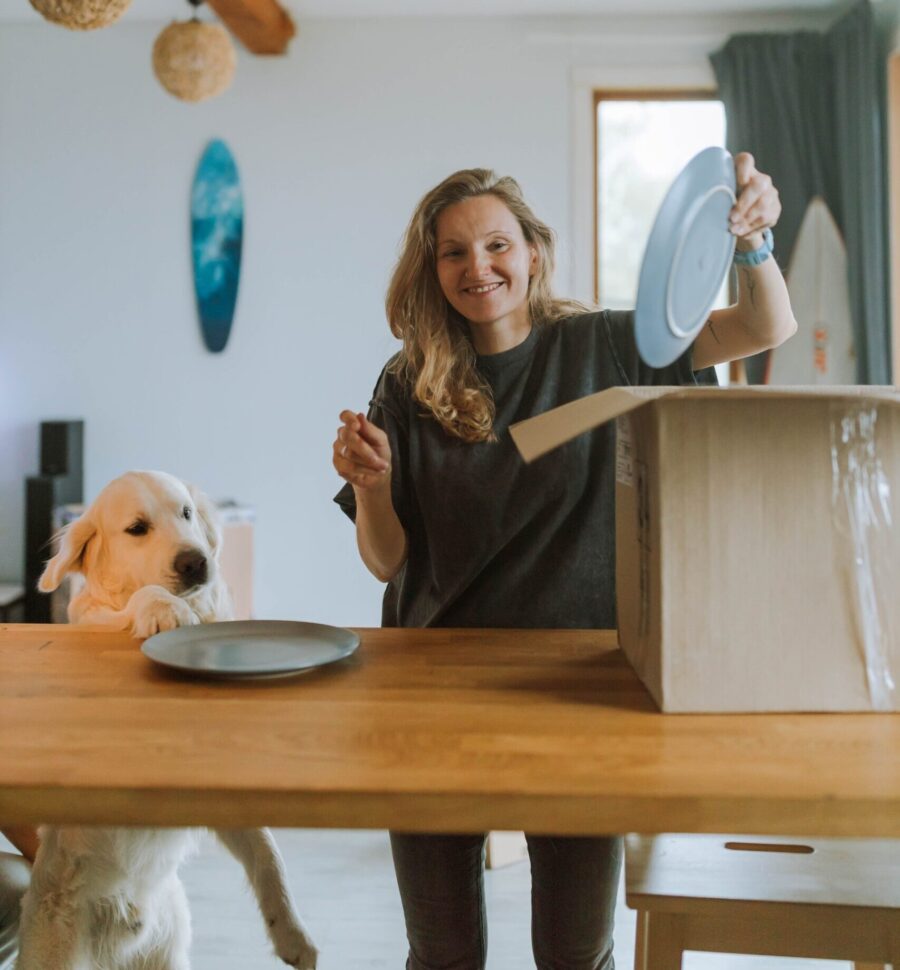Moving homes is a massive undertaking that is recognised as one of life’s stressful events. Researchers have found that moving homes regularly has significant impacts upon adults and children. While moving home can be a hectic and stressful event for people, dogs also find moving home stressful.
The change in routine, changes in the home environment as the de-cluttering, packing and deep cleaning occur, the elevated stress levels in the household, visitors and strangers inspecting homes for sale etc. can upset even the most well-adjusted, social and resilient dogs.
Fortunately, there are steps we can take to make moving homes with a dog less stressful for our canine friends.
Here are my top tips to help your dog move homes.
Before moving with your dog
- Wherever possible, let your dog visit the new home a few times with the aim of creating positive associations with the new home. Help your dog become familiar with the home by staying with your canine friend and
- letting your dog explore the new home and yard
- have some fun with your canine friend while at your future home. Perhaps give them a long-lasting chew or enrichment activity, play some favourite games or give them a relaxing massage.
- Explore the neighbourhood
- If your dog likes to go for walks;
- Go for walks in the new neighbourhood. Give them time to stop and sniff, explore the area and find some new favourite locations well ahead of your move.
- You might take your canine friend for walks along quiet streets, local on lead parks, local quiet cafes etc.
- If your dog doesn’t like walks;
- Go for drives in the area with the window partially down so your dog can take in the scents of the area.
- Depending upon your dog’s needs, parking your car in areas you may take your dog with you (like local shopping centres, sporting areas etc) and giving them a few treats while they observe the area may help.
- If your dog likes to go for walks;
- Refresh crate training. If you have previously trained your canine friend to accept being in a crate it’s a good idea to reintroduce or refresh crate training.
- Moving can be very hectic with people coming and going, this increases the likelihood that doors or gates may be accidentally left open.
- Using a comfortable crate can help keep them safe during hectic times.
- If your dog is anxious, or has other behaviour challenges, liaise with your dog’s care team (behaviour consultant, trainer, behaviour vet, primary care vet). Together you can develop a plan to support your canine friend during the lead up to the move, during the move and after the move. A medication review may be warranted.
- Plan where your dog is going to be during the move. Will they be staying with you? Staying with friends/family? Be at daycare or at a reputable kennel?
- If someone else will be looking after your canine friend during the move, spend some time familiarising your dog with the daycare, kennel, friend’s home etc.
- If a dog is familiar with and enjoys spending time at the place they will stay during the move will reduce their moving stress.
- Take time to check that your dog’s microchip is working with correct contact details and that they still have their registration and ID tags on their collar with current information.
- Become familiar with the new council’s bylaws and conditions for keeping dogs, dog registration, exercise areas etc.
- If moving states or to very different geographical areas check with local veterinarians if additional vaccinations or preventative health care is needed to keep dogs safe and healthy in that area.
Packing the home
- Let your dog explore the packing boxes and other packing related items.
- During the packing you can give your canine friend a long-lasting chew in the same room so they can ‘supervise’ the packing and have a great time chewing on a safe long-lasting chew.
- Pack your dog’s favourite room/locations in the home/toys last.
- Consider the use of adjuncts to help lower stress. For example, products like ADAPTIL collars/sprays, rescue remedy/flower essences, calming music like relax my dog may help your dog during the packing stage. Consult your canine friend’s care team (including their veterinarian(s), trainer, behaviour consultant) to decide on a strategy to support your dog.
- Try to keep up with your dog’s normal routines as much as possible. Although, increasing exercise and enrichment can be very beneficial at this stage.
The move and unpacking
- Implement your moving day plan.
- When you arrive at your new home – do a safety check of the home and yard (secure fences, no dangerous material around, no access to toxic plants etc.)
- Let your dog explore the home and yard – most dogs will appreciate you being in the same area as they are or that they have easy access to you (no closed doors or barriers between you and your dog).
- Set up your dog’s favourite things first, e.g. their favourite chair to laze on, their favourite beds and toys etc.
- Set up safe spaces for your dog to retreat to if they wish e.g. their crate, your bed, behind a baby gate etc.
- Many dogs find chewing to be a great stress relief, so provide plenty of safe things for your dog to chew including safe toys, long-lasting treats and other enrichment activities.
After moving homes with your dog
It will take time for you and your canine friend to adjust to your new home and become comfortable. Here are a few tips to help with the transition.
Remember, to be patient and compassionate with your dog (and yourself). Give yourselves a bit of a break after doing the hard work of packing, moving and unpacking. Stay home, do relaxing fun activities together for the first few days.
- Sticking to your dog’s routine can help them adjust to the new home. Giving them more things to chew and keeping up with their enrichment, exercise and training routines is beneficial and can help your dog decompress and adjust to their new home.
- Consider using the adjuncts that helped your dog during the packing process for a few weeks after the move.
- Revise toilet training and help your canine friend learn where to toilet. Reinforce your dog well for going to the toilet in desired places.
- You may need to introduce your dog to a new or different doggy door. Be patient and reinforce your canine friend for using the doggy door.
It’ll take time for your dog to adjust to the new home and to become comfortable, so try to stay home with your dog for at least 3 days (ideally longer if possible). Stay home for as long as you can to help your dog settle in, then leave for short periods of time gradually building up to your normal absences.
Monitor your dog for signs of distress when left home alone; dogs that have not shown signs of distress at being home alone previously may do so in the new home.
Separation related problems may reappear in dogs that have a previous history of separation anxiety or other separation related problems. Please seek professional advice promptly if you notice your dog is struggling with being left home alone in your new home.
I hope that these tips help make moving with your dog less stressful for all of you. You might also be interested in this blog post so you can give your dog a better life in your new home.
Remember, professional dog trainers and behaviour consultants can help you support your dog throughout this moving home process.




